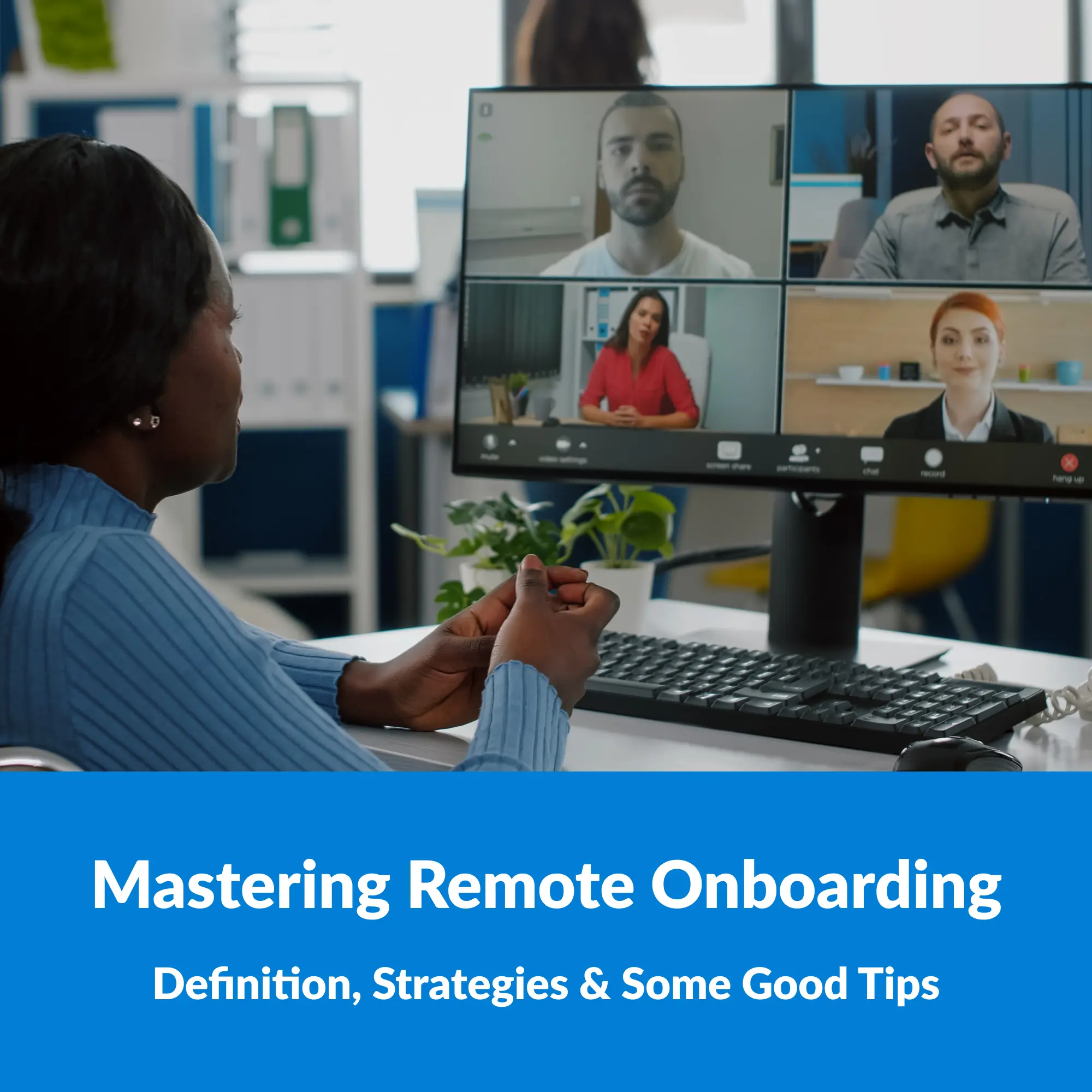The landscape of work underwent a seismic shift with the advent of remote work, becoming a mainstay for businesses worldwide.
According to Forbes 2024, a striking 63% of employees express a willingness to accept a pay cut to work remotely, underscoring the value they place on flexibility and work-life balance. Remote work eliminates commutes, saving the average American employee up to one hour each day, enhancing work-life balance, reducing burnout, and boosting productivity beyond traditional office settings. This transition underscores the significance of mastering remote onboarding processes to ensure the seamless integration of new employees into a virtual work environment.
What is Remote Onboarding?
Remote onboarding refers to the process of integrating new hires into an organization without the need for physical presence. This involves equipping them with the necessary knowledge, skills, tools, and connections to become effective and engaged members of their new team from a distance. The goal is to foster a sense of belonging and purpose, ensuring that remote employees feel as valued and integrated as their in-office counterparts.
Strategies for Successful Remote Onboarding
Successful remote onboarding requires a structured approach that encompasses several key strategies:
1. Creating a Welcoming Digital Environment
– Pre-Onboarding Communications: Initiate contact with new hires before their official start date to convey excitement about their joining the team. Share a welcome email or package digitally that outlines what they can expect in their first week, including schedules for meetings, training sessions, and any required paperwork. This early engagement helps reduce first-day anxieties and builds anticipation.
– Digital Welcome Packages: Beyond traditional welcome emails, consider sending new employees digital welcome packages. These can include virtual company swag (e.g., branded wallpapers, digital notebooks), access to necessary software and tools, and personalized messages from their new team. Such gestures make new hires feel valued and part of the team from day one.
2. Establishing Clear Communication and Support Systems
– Structured Virtual Onboarding Schedule: Provide a detailed onboarding itinerary that outlines activities for the first weeks or months. This schedule should include virtual meet-and-greets, training sessions, and regular check-ins. A structured approach ensures that new hires understand their onboarding journey and what is expected at each step.
– Dedicated Onboarding Buddy System: Pair new hires with an onboarding buddy or mentor within their team. This person acts as a go-to resource for any questions or support needed, helping new employees navigate the company culture and work processes. The buddy system also facilitates informal learning and quicker integration into the team.
3. Leveraging Technology for Effective Training and Integration
– Interactive Online Learning Modules: Utilize interactive e-learning platforms to deliver role-specific training and general company information. Interactive modules, including quizzes, simulations, and videos, can make learning more engaging for remote employees. Ensure that content is accessible and can be completed at a pace that suits individual learning styles.
– Virtual Reality (VR) Onboarding Experiences: For roles requiring a deep understanding of physical spaces (like manufacturing plants or retail environments), VR can simulate in-person experiences. This innovative approach allows employees to familiarize themselves with workspaces and processes without being physically present.
4. Building a Culture of Inclusion and Engagement
– Regular Virtual Team-Building Activities: Organize regular team-building activities that are inclusive of remote workers. Virtual coffee breaks, online games, and group wellness activities (like guided meditation sessions) can promote team bonding and reduce feelings of isolation.
– Feedback and Continuous Improvement: Implement a feedback mechanism to gather insights from new hires about their onboarding experience. Use this feedback to continuously refine and improve the onboarding process. Acknowledging and acting on feedback demonstrates a commitment to employee satisfaction and continuous improvement.
– Recognition and Inclusion in Decision-Making: Ensure that remote employees are recognized for their contributions and included in team decisions and brainstorming sessions. This practice fosters a sense of belonging and shows that their input is valued, regardless of their physical location.
Some good tips for remote onboarding to make employees feel engaged and connected
1. Cultivating Personal Connections
– Personalized Welcome Videos: Create personalized welcome videos from team leaders and members for new hires. This gesture adds a personal touch that text-based communications cannot match, making new employees feel warmly received into the team.
– “Get to Know You” Sessions: Schedule informal virtual meetings between new hires and their colleagues across different departments. These sessions allow employees to learn about each other’s roles, interests, and backgrounds, promoting a more cohesive work culture.
2. Enhancing Communication and Collaboration
– Regular Virtual Town Hall Meetings: Host company-wide virtual town hall meetings where leadership can share updates, celebrate achievements, and address questions. These meetings reinforce transparency and give employees a sense of involvement in the company’s direction and success.
– Dedicated Virtual Social Spaces: Create dedicated channels on communication platforms (like Slack or Teams) for non-work-related conversations. Channels focused on hobbies, pets, or book clubs encourage casual interactions that can lead to stronger interpersonal connections among team members.
3. Supporting Well-Being and Work-Life Balance
– Flexible Scheduling: Recognize the diverse needs and time zones of remote workers by offering flexible scheduling. Allowing employees to work during their most productive hours can improve work-life balance and reduce burnout.
– Mental Health Days and Support: Encourage taking mental health days and provide access to resources like counseling services or wellness apps. Acknowledging the importance of mental health fosters a supportive environment where employees feel valued beyond their work output.
4. Encouraging Professional Development and Growth
– Personal Development Plans: Work with remote employees to create personalized development plans that align with their career aspirations and the company’s goals. Regularly review these plans and provide resources or training opportunities to support their growth.
– Mentorship Programs: Establish virtual mentorship programs that pair less experienced employees with more seasoned colleagues. These relationships can facilitate knowledge transfer, provide support, and enhance career development.
5. Recognizing and Celebrating Success
– Virtual Recognition Platforms: Utilize virtual platforms to recognize and celebrate employees’ achievements, milestones, and contributions. Public acknowledgment in front of peers can boost morale and motivate others.
– Team Achievements Celebrations: Celebrate team successes with virtual events or by sending small tokens of appreciation, such as gift cards or company swag. Recognizing collective achievements reinforces the value of teamwork and collaboration.
6. Leveraging Technology to Enhance Engagement
– Interactive Virtual Events: Organize interactive virtual events, such as workshops, guest speaker sessions, or live Q&As. These events provide learning opportunities and break the monotony of daily routines.
– Gamification of Work Processes: Introduce gamification elements into work processes or learning activities. Leaderboards, challenges, and rewards make achieving goals fun and can increase engagement and motivation.
7. Simplifying Technology Onboarding and Use
– Personalized Learning Paths: Digital adoption platforms (DAPs) offer personalized learning paths that cater to the unique needs and skill levels of each employee. By providing just-in-time guidance and support, DAPs ensure that remote employees can quickly become proficient with new tools, reducing frustration and increasing satisfaction with their work environment.
– Interactive Onboarding Guides: DAPs can create interactive, step-by-step guides for new software and systems, making the onboarding process more engaging. These guides can be particularly beneficial for remote employees, who might not have immediate access to in-person assistance, ensuring they feel supported and confident in using essential tools from the start.
By implementing these tips to foster engagement and connection, companies can build a vibrant remote work culture where employees feel valued, supported, and integral to the organization’s success. Such an environment not only enhances productivity but also attracts and retains top talent in a competitive market.
Build a strong onboarding experience with Opus
Onboarding remote employees doesn’t have to be a challenge.
Platforms like Opus, a digital adoption platform, can streamline the process. With Opus, you can easily record your application processes and tasks and automatically generate help and guidance content (job aids, simulations, walk-throughs, digital books and AI summarized content).
This content is proactively delivered to the new hires as they work, on their applications, based on suggestions made by Opus. No leaving their work, no hunting for the right instruction, while allowing the new hire to select the guidance format they like best.
Conclusion
The ability to effectively onboard remote employees is a critical competency in today’s digital age. By embracing innovative strategies and leveraging technology like digital adoption platforms, organizations can create a robust onboarding experience that ensures remote employees feel welcomed, valued, and prepared to contribute to their new team’s success. The future of work will always include remote, and mastering remote onboarding is key to attracting and retaining the best talent in this evolving landscape.










